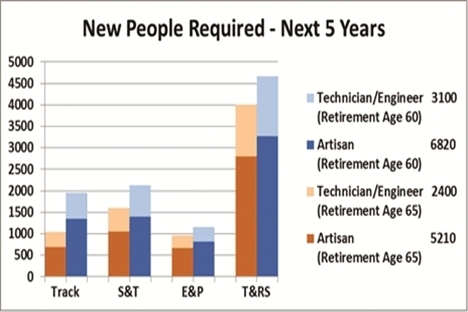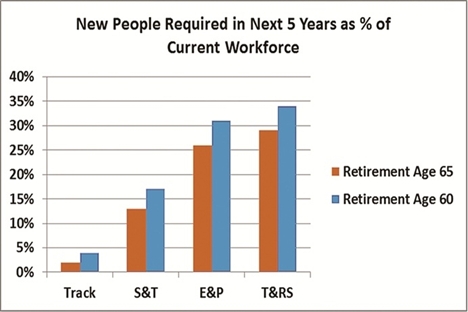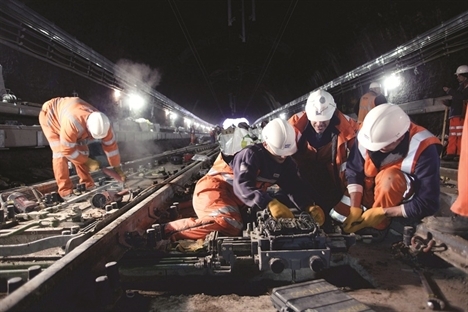28.02.13
Forecasting the need for jobs and skills across the rail industry
Source: Rail Technology Magazine Feb/March 2013
One of NSARE’s major projects over the past year has been producing a skills forecasting model for the entire industry. RTM discusses its findings with NSARE chief executive Gil Howarth.
In March 2012, the ORR commissioned the National Skills Academy for Railway Engineering (NSARE) to produce a skills forecast for the industry and RTM spoke to NSARE’s Elaine Clarke in our April/May 2012 edition about the work being done for the project, which updates and expands work done in 2009 and 2010 before NSARE was formally established as a not-for-profit company limited by guarantee.
The findings of the skills forecasting report have been revealed to leading figures within the industry in recent months, and in January 2013, NSARE published the outputs from its work.
The figures, which apply to Network Rail, Transport for London, Crossrail, HS2, the light rail sector, the train and freight operating companies and all their railway engineering supply chains, were ‘common sense checked’ with stakeholders throughout the industry and have been agreed, with some of the key messages on the number of people required across different rail sub-sectors published in the graphs below.


A flexible model
As part of the project, NSARE now has an aggregated programme of more than 200 rail projects, of which 140 have yet to start implementation.
NSARE said: “The model has been developed and is working; skills forecasts can be generated against a range of scenarios by adjusting the input assumptions. The response has been very favourable; there is general agreement that the work provides a firm basis for updating the Skills Strategy that NSARE published in February 2012.”
NSARE’s chief executive Gil Howarth told RTM more about the model, which he said he would describe as “flexible”.
Although it’s capable of making complex calculations, the model itself can be easily updated by making simple changes to the assumptions on which it’s based. Howarth said: “For instance, we can simply put in the retirement age, and the model recalculates the numbers, because we don’t know if the average retirement age is going to be 60, 65 or somewhere in between.
“There are some incentives for ex- British Rail people to retire early, whereas some people with mortgages and grandchildren during the recession may very well decide to stay on until after 65.
“There are a number of assumptions around the project investment programme we can change: the duration, the start date, the value – and the model will compensate for that.”
Sensitivity of different sectors to improved efficiency can be included, and even though the model can’t predict new technologies that may alter the jobs and skills mix required by the industry, it’s flexible enough to be adjusted as time goes on.
ORR’s director of rail safety, Ian Prosser, told RTM: “The regulator welcomes publication of the Skills Forecasting report, commissioned from the NSARE to provide ORR with a long-term overview of rail industry skills, competence and resources.
“While the report highlights some areas of concern, notably a growing difficulty in sourcing well-qualified and experienced staff, it also recognises the steps already being taken by the industry to ensure adequate training and support is in place to help today’s apprentices develop into tomorrow’s experts.
“The report findings will inform ORR’s proactive safety inspection regime and our assessment of what Network Rail must achieve during the five years from 2014 to 2019, the funding needed, and the incentives required to encourage delivery and outperformance.”
Strategic Business Plan
The work was referenced in the Industry Strategic Business Plan: “On behalf of the rail industry, the National Skills Academy for Railway Engineering (NSARE) has undertaken a skills forecasting exercise to predict the resources required to deliver the ISBP in parallel with Transport for London’s investment programme, HS2 and light rail schemes.
“The model predicts the number of engineers, technicians and artisans required for Track, Signalling & Telecommunications. Electrification & Plant and Traction & Rolling Stock.
“Initial findings have resulted in NSARE working with Network Rail and the Rail Industry Association (RIA) on the specific Electrification & Plant skills challenges. In addition, NSARE has submitted a bid to BIS (Department for Business, Innovation and Skills) for a National Training Academy for Traction & Rolling Stock, in conjunction with Siemens plc.”
Howarth said NSARE and Siemens are pressing the Government to make a decision on the proposed academy at Northampton King’s Heath as soon as possible. Siemens’ Graeme Clarke spoke about the academy at NSARE’s ‘Training Matters’ conference in September 2012, saying: “We’ve got a lot of trains in service and a lot of trains about to come into service. And that’s given us a major problem. It’s an industry-wide problem. And the problem is that we are chronically short of people. The industry in all its aspects is moving away from the hammer, and moving very much towards the laptop, and the quality of the people we need is ever-increasing.”
The academy would include: two 7m x 7m training rooms; one 7m x 8m virtual reality training room; four 8m x 8m ‘dirty’ training rooms; two assessment rooms; a main 400m2 workshop; an electronic ‘clean’ room; and an 80m long segregated railway siding. It would have functioning training equipment including bogies, door rigs, a traction inverter, an auxiliary inverter, traction control equipment, a pantograph & VCB, a wiring cubicle, brake control equipment, a HVAC Unit, an auto coupler, train mounted signalling equipment, OTMR and PIS.
Age profile
Asked about the extent to which the age profile of the current railway engineering workforce is having an impact on the future skills needs and skills gap in the industry, Howarth told us: “It’s different on the infrastructure side than to traction and rolling stock. On the infrastructure side, the profile amongst track, signalling, telecoms, electrification and plant is very similar: that, in itself, is not posing a huge problem. The concern is that the older members of the workforce have got a huge amount of knowledge: we’ve got to, before they retire, make sure that knowledge is transferred to the younger members of the workforce.
“Already there is a mentoring programme being put in place on electrification, for example.
“For traction and rolling stock, there is a really serious problem: 20% are aged over 55. If you then take that combined with the ordering of four new train fleets – Crossrail, IEP, Thameslink, LU – then that’s why traction and rolling stock, we would suggest, is the biggest challenge of the four sub-sectors. That’s why we want to build the new national training academy.”
On electrification, NSARE is working with Network Rail and RIA as part of an industry steering group to ensure the workforce is in place for the years of upcoming electrification projects across the network.
Next steps
NSARE is due to meet with the ORR soon, Howarth said, to “decide what role if any they wish to play in recruitment, training and development of the workforce”.
He said that now the model in place, skills forecasting will become a rolling project for NSARE. “I would foresee that we would publish this type of report on an annual basis,” he said.
Asked about the next steps for ensuring the industry acts on the messages in this first skills forecast report, Howarth mentioned the fact that it appeared in the Strategic Business Plan and added: “I think the industry is now conscious that it needs to do something.
“The next step is, what is it going to do – and who’s going to lead? We’ve had initial discussions with the DfT, we’ll have discussions with the regulator, we have our own discussions with our industry board.
“It’s all about where we go from here.”
Crossrail 2
Elsewhere in this edition, RTM discusses the latest push on Crossrail 2, the Chelsea-Hackney line.
At £12bn, this would be another major infrastructure project with large workforce requirements.
Howarth said: “We absolutely welcome it. It’s a piece of infrastructure that has been known to be needed for some time.
“Yes, of course there’ll be additional resources required and skills. But I think that with the Tunnelling and Underground Construction Academy in place, and the skills forecasting work which provides a very good foundation for predicting what rail engineers will need for the future, then if Chelsea-Hackney, Crossrail 2, does start to gain support and becomes a project, rather than a proposal, then we can feed that into our model.
“We’ve got the initial phases of HS2 in our model, so it will be another project which would feed in."
Aims of the skills forecast
• Provide a medium term view of skills requirements – number of people, skill levels and disciplines – to enable the industry to plan for the future.
• Provide a basis for collective action to address the challenges to ensure that the industry can deliver on its investment commitments.
• To inform discussion with Universities and FE Colleges about the industry’s future education and training needs and with Government on its skills funding priorities.
• To identify specific challenges where more in-depth analysis is required.
The project activities included:
• Creation of a database of the current workforce by sub-sector (Track, Signalling & Telecommunications, Electrification & Plant, Traction & Rolling Stock), gender, age, skill level (semi-skilled to Professional Engineer) and geography.
• Development of an aggregated programme of all the infrastructure and T&RS renewal and investment projects.
• Development of algorithms to predict the resources required to continue to maintain the assets and to implement the projects; numbers and skill levels. • Development of the skills forecasting model, which was originally created in 2009 and was used to support the preparation of the original NSARE Business Plan.
• Generation of a gap analysis of the resources required.
